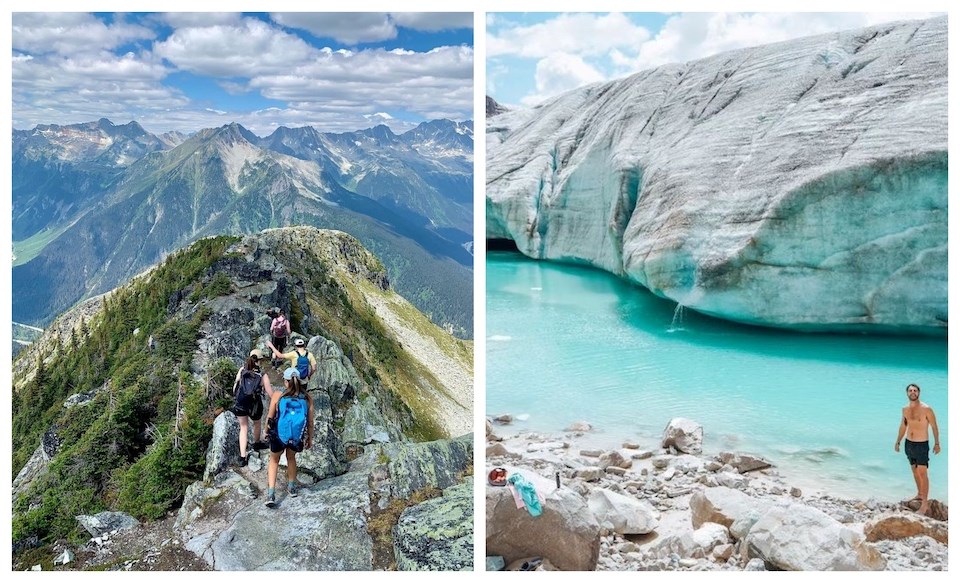Travellers looking to explore Glacier National Park near Revelstoke will enjoy panoramic alpine views on every hike and might see some B.C. wildlife, too.
Comparable to the Rocky Mountains, the expansive national park encompasses over one million acres and includes 43 parks and park reserves across Canada, including a portion of the Selkirk Mountains. It contains lush, mossy forests and massive active glaciers one of the largest cave systems in the country.
If you only visit for an hour, there are great opportunities to take a break from driving and experience the scenery beyond the edge of the highway.
According to Parks Canada, the Rockgarden Trail takes about 20 minutes, offering "an intimate view of the diminutive nature of the park, nestled among sweeping views of the Selkirk Mountains wilderness."
Visitors who can afford to spend a day in the park can see several attractions and hike multiple trails. Their trip can start at the Rogers Pass Discovery Centre, which offers up-to-date park information, visitor services, and interpretive exhibits. It's an ideal place to plan the day and what trails you can accomplish.
The trails range from short, valley-bottom strolls, to steep, tough climbs across the Columbia Mountains. There are also places to stroll to that offer mesmerizing perspectives of the area, including the Slide Path that stretches 1,500 meters, "from the valley floor up to the very gates of the Selkirk Mountains," according to Parks Canada.
The government offers several examples of one-day itineraries and long weekend ideas, too.
Where can I stay to explore the park for several days?
Visitors can reserve campsites at Loop Brook Campground and Hermit Meadows backcountry campground. All other campgrounds assign sites on a first-come, first-served basis, according to Parks Canada.
Travellers who prefer to stay in hotels or motels can find accommodation nearby in Revelstoke or Golden. A couple of mid-range cost options in Revelstoke include the Swiss Chalet Motel, the Ramada by Wyndham Revelstoke, and the Revelstoke Lodge.
When is the best time to hike on trails in the park?
Hikers should always brace for poor weather when they venture into the mountains; unpredictable conditions are possible any time of the year. Before you head out, check the forecast and consider the risks.
It is possible to hike in parts of the park in the spring from early May to late June. While higher-elevation trails are snow-bound and may have avalanche hazards, some lower-elevation trails may be accessible. Most of the trails are accessed off the Trans-Canada highway.
The prime hiking season is summer, from July to mid-September. There may be some "snow on higher-elevation trails until mid-July" but "subalpine wildflowers typically bloom in August," according to the government.
Hikers who head out in the fall, from mid-September to early October, will experience "shorter days and cooler temperatures" and the trail bridges are "typically removed between late September and early October for the winter."
How will I know if I have the right fitness to embark on a trail?
Parks Canada offers a guide for the national park that rates trails on a three-level system, factoring in elevation, prior experience, and the number of obstacles.
The estimated time to complete a trail will differ based on the trail distances, fitness levels, weather, and conditions.
Here are the government-provided skill levels:
Easy trails
- Suitable for those with little or no trail experience.
- Flat to gently rolling with few obstacles.
- Little or no elevation change.
Moderate
- Suitable for those with basic trail experience.
- Gently rolling with short, steep sections and infrequent obstacles.
- Moderate elevation change.
Difficult
- Suitable only for those with trail experience.
- Long, steep sections with frequent obstacles.
- Major elevation change.
lnmlnknlk
Do I need to bring anything with me when I go?
It is possible to get lost or stranded in Glacier National Park. While most people will be safe if they gauge their prior fitness level before embarking on a journey, they should bring essential supplies for emergencies.
Some of these supplies include a trail guide and map, a full water bottle or thermos, high energy food, bear spray, bug spray, sunscreen and sunglasses, a first aid kit, headlamp or flashlight with spare batteries, a hat and gloves, hiking poles, fain/wind jacket, extra warm clothing in case of an emergency, and a cell phone or satellite communication device.
Always travel with someone or a group and don't leave anyone behind. The government recommends you "choose a trail suitable for the least experienced member in your group" and not wear earbuds to stay alert.
Risk of Lyme disease
Ticks carrying Lyme disease may be present in the park and you must check yourself and your pet(s) for ticks after hiking. You should also wear protective clothing to prevent being bitten. Use bug spray containing DEET or Icaridin on your skin and clothing.
If you find a tick on your body or your pet, remove it with fine-point tweezers. Removing it within 24 to 36 hours can help prevent infection, according to the Public Health Agency of Canada (PHAC).
Things to consider about wildlife in the park
The park is home to wolves, cougars, grizzly bears, black bears, mountain goats, beavers, muskrats, and other wildlife. Some of these animals are viewable from the Trans-Canada highway.
Travelling in groups is one of the best ways to prevent interactions with wildlife on trails since they generally avoid loud, unfamiliar noises. Talk to each other throughout the hike.
If you do see an animal, give it space. The government recommends you carry bear spray outside of your pack for easy access and know how to use it.
Campers and hikers can also mitigate the risk of attracting bears by bringing garbage and not tossing organic materials.



